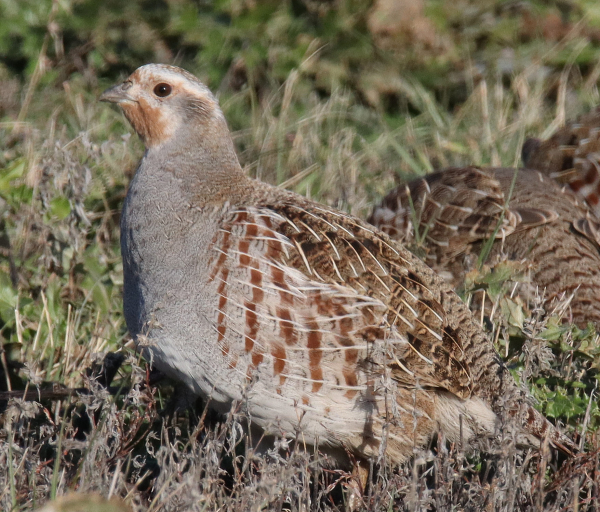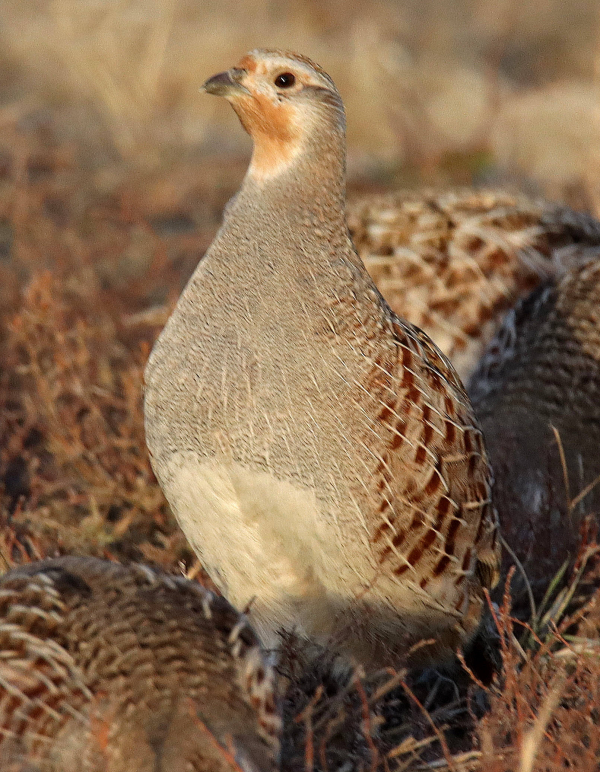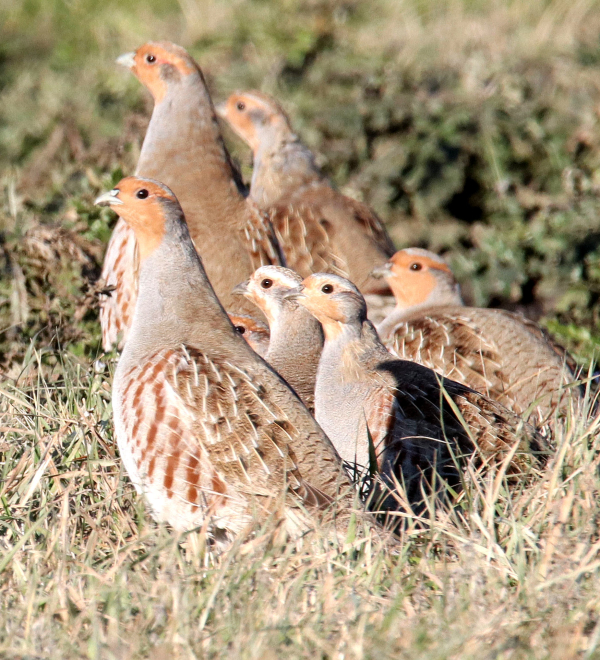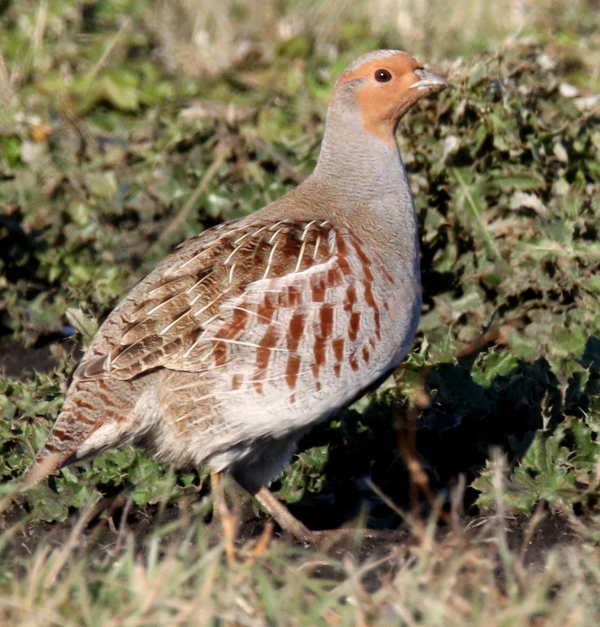Last week I was on a bit of a mission as I returned for a second photo session with Gray Partridges that I’ve been seeing regularly on the edge of the city of Fargo. Partridges have become increasingly rare it seems, but the edges of Fargo and West Fargo appear to be an area where they have become established and flourish in some neighborhoods and the edges of the city. I’ve been hoping to photograph partridges since my friend Ross send me photos of partridges he took during winter in his yard on the edge of West Fargo. Although I saw Gray Partridges in his neighborhood, I didn’t get a photo and felt kinda funny trying to photograph birds in peoples’ side yards from the street – ha.

During a July dinner stop at a Freddy’s drive-in in south Fargo, I found a pair of Gray Partridges in a strip mall behind the drive-in that provided a few images as they foraged in front of a real estate office after hours – ha-ha. But I had a bit of a breakthrough when I visited the lot where my niece and nephew, Krista and Casey, are having a home built in a new housing development. I’ve seen 1 or 2 coveys of partridges in the surrounding area during each of my visits to their new homesite. After the foundation was poured I took some photos, and while texting them to Casey and Krista in Tampa, a flock of a dozen partridge flew into their front yard and began foraging on the available weed seeds – ha-ha-ha.
While leaving, I drove through the area and found another flock of 7 Gray Partridge, along with 6 White-tailed Jack Rabbits in the area scheduled for future development to the south. While the north side of the development has new and on-going construction, the south side of the expansive property is an open field of grass and weeds that’s mowed short. I didn’t see any photo ops then, but 2 weeks ago when I stopped by I found a flock of 9 partridges feeding on the edge of the weedy field where I could park my car and use it as a photo blind with the sun at my back.

I managed to get a few really nice photographs, and that’s when I noticed that some of the partridges looked different than I would expect. About half of the partridges seemed to have a lighter coloration overall, emphasized by distinctive white “bridled” lines around the orange facial plumage. I have never seen this coloration among Gray Partridges, in the field or in museums, but my photographs showed them distinctly. I believed I had enough representative photos of the partridges to create a Bird Photography article about that initial photo session, but after editing photos for an article, I felt the need to try to learn more about this plumage variation.
The Return
I wanted to get to the partridge territory early last Wednesday and arrived about 2:40, but during my first search for a flock, I drew a blank, until at the very end of my area survey I sighted some “lumps” barely discernable above the level of the mowed plants in the big field south of Krista and Casey’s home lot. Thinking the lumps could be a flock of partridges, I checked with binoculars, and sure enough, one of the partridges raised its head high on the lookout.
It was great to find a Gray Partridge covey in the area, but they were on the far side of a field that I didn’t want to enter with my vehicle, and I didn’t think it would be wise to try to approach them on foot. Looking for the best possible option I circled the field, and by the time I returned to the flock, they had foraged to a position within 20 feet of the vacant street on the far end of the development. Even so, the sunlight was coming from the southwest, and the birds were located directly north of the best position I could park – darn. I waited, probably being too patient and too concerned that I would interrupt the partridges’ feeding session, but the birds come first.

The covey numbered 10, but in a few minutes I noticed other partridges ambling in from some thicker weeds, and although that flock of 7 was close, it stayed apart the closer flock, which was an interesting observation in itself. As I waited for the partridges to get into better position, it was really quite pleasing to watch the birds feeding so close together and hearing their low contact calls. It was obvious they were keeping a low profile, staying at or below the surrounding vegetation, but every so often one would stand up to look around, providing a chance to try to photograph it if the bird angled into the sun, thereby creating the least shadowing.
When a big construction truck drove by it disturbed the covey, and all of them stood upright and began running, which turned things to my advantage – finally. After the loud truck rumbled by the flock took a quick low flight across the street, which gave me a chance to photograph with the sun directly at my back. After repositioning my car and thereby giving the covey some time to settle into feeding again, I decided to try a different tack. I exited my car, which is usually a bad idea because wildlife tends to flee from the sight of people. But these were suburban partridges and I knew they were familiar with people walking along the street, sometimes even as they were walking a dog, so decided to try a closer approach.

Note that this bridled female Gray Partridge has a white belly, devoid of the chestnut-colored horseshoe or oval found on some females and all males (600mm zoom lens, f-8 aperture, 1/500 shutter speed, 800 ISO).
|
Actually, I used a parked bulldozer as cover, with the sun at my back and the partridges before me, and the bulldozer helped to break up my people silhouette too. Obviously, this wasn’t my usual mode of photographing birds – usually I am in pretty remote natural settings – but there I was on the edge of a housing development using a bulldozer as a screen – ha. Eventually I was able to stand upright, which provided a better elevated photo angle considering the partridges continued to crouch low with their head down feeding.
The partridges were fine with my approach and position, and I appreciated the chance to spend time among them, photographing when an individual stood up or walked a few steps to reposition, which was actually rare as they huddled in groups low, and out of sight as they fed. If you didn’t know they were there, you would surely walk past them, or the covey would flush to your surprise.
Tech Talk
During the 2 Gray Partridge photo sessions, I used the ISO 800 setting I’ve been using lately for waterfowl photography, which increases the effect of sunlight over my standard 400 ISO setting. I believed I needed a more light-sensitive setting with the birds foraging among relatively dark vegetation. As the sunlight was noticeably dimming at the end of the second photo session, I even felt I needed to use an ISO of 1600, but those images didn’t fare well color-wise.
Earlier in the afternoon, the ISO 800 provided a chance to use a faster shutter speed and a much wider aperture setting than usual, up to f-11. The resulting shutter speeds were still more than adequate, varying from 1/1000 to 1/640, especially considering the Gray Partridges were not very animated during my observations. I tried not to get too close to the partridges, hoping not to disturb them, and that was best accomplished by using my lenses’ highest zoom level of 600mm. Then too, I could enlarge the photos a bit by cropping some background from the image after downloading selected photos into the photo editing software on my computer.

Bridled Partridge Plumage
During the second photo session, I tended to emphasize trying to photograph some of the “bridled” birds with the hope of documenting them better. After checking online photos provided by Birds of the World and All About Birds, I saw there were a couple similar examples of “bridled” Gray Partridges, but none showed the strong white lines that the bridled partridges before me showed – and none of the photos were described as females of immatures to indicate their distinctness from the “normal” Gray Partridge images. Most concerning though was that the white bridled coloration on some of the partridge’s face and throat was not mentioned in the detailed plumage descriptions of the species by the top Gray Partridge biologists that authored the Birds of the World species account.

Just a nice species portrait, sometimes overlooked for lack of action, but this photo shows perfect colors and sharp focus with a certain cute quality (600mm zoom lens, f-13 aperture, 1/500 shutter speed, 800 ISO).
|
I also checked my Sibley field guide, my Peterson field guide, and several others, but nothing; until I consulted Birds of Europe by Lars Jonsson, which had an illustration identified as a female that showed subdued bridled white lines on its face and throat – but no description of it. I also emailed a few friends to see if they had an insight, and they did, so thanks to Jim, Kris, Whitney, Brian, and Kristine (who just happened to be in Casa Blanca, Morocco!).
Perhaps my photos and attention to this female plumage type will cast a light onto this interesting identification conundrum I entered into and detailed. What would a beginning birder think upon seeing females with such pronounced white bridled lines? As noted above, about half of the Gray Partridges I’ve seen and photographed in this local population had bridled faces, which suggests half are females – makes sense. But in viewing many photos online, I’m still hesitant to believe that allfemales have the white bridled outline in all parts of their range –I’m still investigating.
As the sun began to dim in the west, I decided I should call it quits, as hard as that was to do. Spending the time with the flock of Gray Partridges truly endeared the species to me. They were all very intent on foraging, keeping a low profile in the process; and while I could hear low contact calls, I never saw any kind of fussing between individuals. Usually Gray Partridges are very wary and rarely approachable, even if you’re trying to get within telephoto lens range. And if they don’t flush from a distance, they quickly slip into thick cover.
But that all changes in the suburbs where housing and agriculture meet, and where the partridges get used to people, vehicles, and even people walking leashed dogs. Knowing that, with my interest in documenting some of the house construction progress for Casey and Krista, I imagined I might get a chance to photograph Gray Partridges eventually. The fruits of searching out partridges during my south Fargo visits paid off in early November as I share them with you here.
Now, having had some success, and after enjoying the company of the trusting Grays, I’m interested in photographing them when there is a cover of snow. I guess I probably won’t need to wait very long before that change in the landscape takes place, so I’ll keep you posted. In the meantime, search out trusting birds to photograph in your neighborhood and wherever you find them as you enjoy late fall birding activities.
Article and photographs by Paul Konrad
Share your bird photos and birding experiences at editorstbw2@gmail.com